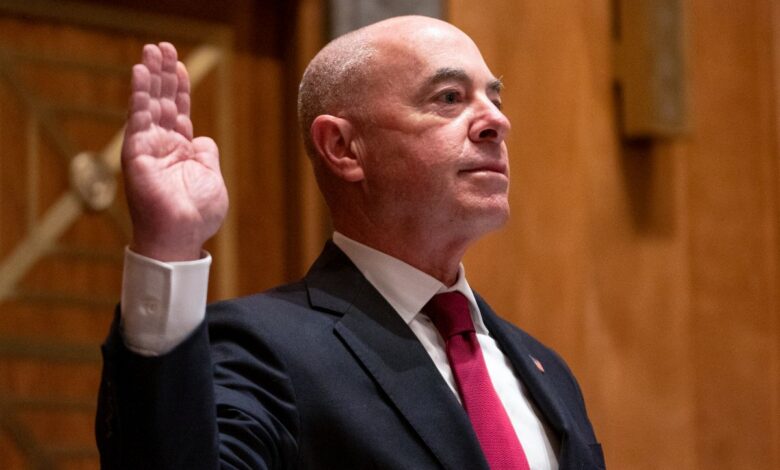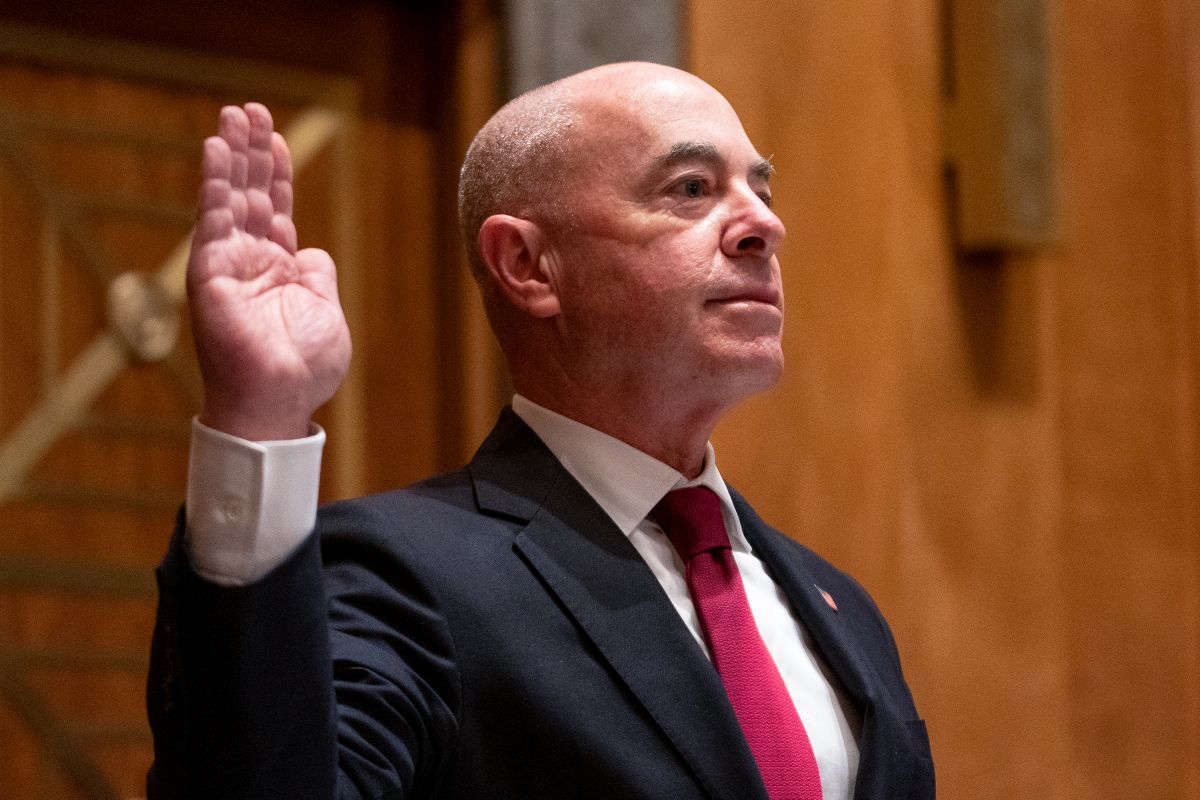The US will try to expel Haitians to South American countries if there is a new wave


The United States is negotiating with South American countries to expel some Haitians and send them there, in case there is another wave of migrants from that nation to the country’s border, US Secretary of Homeland Security Alejandro Mayorkas told the Agency EFE.
Mayorkas confirmed that The United States plans to re-implement the “Stay in Mexico” program before the end of 2021; and defended the policy known as Title 42, by which the majority of the undocumented who arrive at its southern border are automatically deported.
Question: A month after thousands of Haitian immigrants gathered under the Del Rio (Texas) international bridge and images of agents harassing them from their horses circulated, what lessons has the government learned? Is there something you would do differently if large groups of Haitian migrants arrive at the border again? Do you promise not to return to expel these migrants en masse to Haiti?
Answer: I think the term “mass expulsions” is inapplicable. There were a large number of Haitian citizens who crossed the border at a particular place in a very, very short period of time, which was very unusual for people who have spent three decades working along the border, both in the Border Patrol and community organizations, and we have learned from that experience.
And if there were another movement of individuals like that, we are prepared for it. I know that the State Department is working very intensively with South American countries, from which Haitian migrants most recently traveled, to see if those South American countries would accept the return of arriving Haitian nationals (to the southern border of the United States) between our ports of entry. That is something that is being worked on very energetically.
Q: You announced this week that, in early November, the United States will open its land borders with Mexico and Canada and will require travelers who want to enter a proof of vaccination with a complete schedule. Will the United States accept the entry of those Mexicans inoculated with vaccines that have not been authorized by the World Health Organization (WHO), such as Sputnik V and CanSino?
A: The Centers for Disease Control (CDC) will decide which vaccines will be accepted. And I think that if someone has a vaccine that is not accepted, then the trip will not be allowed, unless there is another exception that they can qualify for.
Q: And are exceptions expected for unvaccinated children?
A: I don’t know the answer to that question, I think it’s something the Centers for Disease Control will decide.
Q: These travelers will be allowed entry from the beginning of November, as will those flying from most of Europe. Do you expect it to be from the first week of November or the second?
A: I think it has not been decided yet. We aim to achieve this as soon as possible in November.
The return of “Stay in Mexico”
Q: A question about the “Stay in Mexico” (MPP) program, which was promoted by the Donald Trump government and for which undocumented immigrants seeking asylum on the southern border of the United States had to wait in the country. neighbor to have your requests processed. A federal judge has ordered the White House to reinstate that program, and Congressman Henry Cuéllar has said that the policy will restart “sometime next month” in Laredo, Texas. Could you confirm that? And will it restart only in Laredo or elsewhere as well?
A: We ended that program and we were sued for doing it. And now we are under a court order to implement that program, not just in Laredo, but along the entire southern border. That is a court order that we are obligated to follow, and therefore we must comply with it, and we are obligated to implement it as quickly as possible. And to do that, we are in talks with the Government of Mexico, because both countries are required to agree to that program.
Q: And you can’t confirm that it will restart next month?
A: I can’t. It is our duty in court to implement it, to initiate it as quickly as possible and we are working to do so, despite our opposition.
Q: But it will probably be this year, right?
A: Yes.
Q: And secondly, how will you ensure that once you restart this program, migrants expelled to Mexico will be protected from human rights abuses that have occurred in the past, such as rapes or kidnappings? Are you talking to the Mexican authorities to guarantee better conditions for migrants?
A: We are working very closely with the Mexican government, that is one of the important topics of our conversations with them. And, of course, they share that commitment to serving the needs of the people who are subject to the program.
Q: You have promised to issue a new measure to end MPP again. Should we hope that, once the program is restored, it will not last long in force, because it will be canceled again?
A: I think that is most likely to be decided by the courts. Our Administration has indicated that it will issue a new memorandum in light of the court ruling, and what may happen thereafter… I think we are going to have to let the judicial system decide.
Title defense 42
Q: Under Title 42, the United States automatically deported most undocumented adults who arrive at its southern border, sheltering itself from the pandemic. Thousands of migrants are being expelled without even being able to argue that they have a credible fear of persecution if they are returned to their home countries, something that is a basic right under US law and international asylum standards. You yourself are an immigrant who came from Cuba, how can you continue to justify this policy?
A: I think your question is very important and very fair. It is very important to understand that Title 42 is not an immigration policy that we have adopted. I would disagree if someone tries to define our immigration policies by referring to Title 42. Our immigration policies are defined by our restart of DACA, our strengthening of DACA; for ending the public charge rule that deprived immigrants of access to benefits; for removing barriers to naturalization; for providing new guidelines to immigration agents to protect 11 million (undocumented) people from unjust deportations (…). Title 42 is a public health authority that the Centers for Disease Control has and they have ordered that it be used, because we are in the middle of a pandemic and hundreds of thousands of people, in this country alone, have died due to that. pandemic.
Q: Yes, but more and more health experts are speaking out against Title 42 and saying there is no evidence that this policy prevents the spread of Covid-19. In addition, that measure does not apply to other travelers entering the US Are you not concerned that this could fuel the discourse that migrants are carriers of disease, and that this increases discrimination against them?
A: I am very, very concerned about any false narrative that has anti-immigrant sentiment, and I can tell you as an immigrant. But traveling to the United States with a (legal) method is very, very different from crossing the border between ports of entry, and having to be taken out of necessity to a Border Patrol station, which is not capable of isolating and putting quarantine people who have covid. We have seen the rate of covid-19 infection rise for months among the migrant population at Border Patrol stations – it went from about 12% at first to around 20%. And we’ve seen unaccompanied children in crowded settings become infected with COVID-19. Therefore, this is an effort to protect the migrant population itself. And I would respectfully tell you that experts at the Centers for Disease Control would disagree with that argument.
Q: Are you concerned that if Title 42 is ended, there could be a huge wave of undocumented immigrants at the border? Isn’t that a factor in the government’s decision to keep it standing?
A: No. We are prepared to address migration as it occurs at our borders. We have shown our readiness for it. And the decision to apply Title 42 is not a decision based on border management. It is based on public health facts and data that the Centers for Disease Control evaluates and determines.
Q: And you don’t think the Administration is violating its international asylum obligations?
A: There are exceptions to the application of Title 42: (those provided for in) the Convention against Torture, or (those that concern) individuals who have special vulnerabilities. We don’t apply it to them. And we continue to believe that the enforcement of Title 42 by the Centers for Disease Control is, in fact, legal.
Q: If it wasn’t up to the CDC but up to you, would you stick with this policy?
A: It is quite clear that a large number of families have the opportunity to defend their case, and that is shown by the data. We were considering a different approach than Title 42 when success in fighting the pandemic warranted a different approach. But then the delta variant came out, with great force and impact, and that was a real setback for the welfare of the public from a health perspective, so we (continued) using Title 42.
Other obstacles to the asylum system
Q: Before coming to power, President Biden said it would take him about six months to fully reestablish asylum processing at the border. He has been in power for almost nine months now, and I know that not everything works exactly as it should because of Title 42, but if the pandemic ends and things return to normal, is the asylum system ready?
A: What underlies Title 42, the state of the pandemic, is a very significant obstacle, but there is more as well. There is the fact that in the last four years, the United States Citizenship and Immigration Services agency (Uscis) has been financially decimated due to the policies and practices of the previous administration, and we are rebuilding that agency (…). Only now are we re-hiring asylum officers and building the staff, equipment and facilities to process humanitarian aid requests. That is one of the obstacles that we are encountering and that we are overcoming.
Q: You also just announced the end of raids on workplaces in the United States, what effect do you expect that to have on the undocumented population?
A: The fact that someone is illegally present in the United States is not, by itself, a basis for taking enforcement action against them. That was a principle that I expressed in September (…), and what we are going to do is focus our efforts on exploiting employers, who take advantage of the vulnerability of workers who may not have documentation; to focus our efforts on those unscrupulous employers.
Keep reading:
– Border patrol rescued 7-year-old girl abandoned by human smuggler at the foot of the border wall in California
–Binational Health Week 2021 begins with medical services for Mexican migrants in the United States
–Activists demand immigration reform with 400 banners in front of Congress
.



